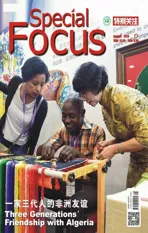The Success Story of Sheng Maobai
2018-08-31ByLiuYishan
By Liu Yishan
Sheng Maobai, the owner of the Shengning Store,is an old friend of mine.He has experienced vicissitudes of all kinds throughout his life;he spent five years in prison and after being rehabilitated, he returned to his former workplace.In the early 1990s, Sheng Maobai retired early from his previous employment in Daye County,Huangshi, a city in Central China’s Hubei Province, and then came to Wuhan, the capital city of Hubei, where he opened up the Shengning Store, a small painting and calligraphy shop.His business was engaged in collecting and selling paintings,which required the unique ability of collecting the right items and selling them at the right price. I was a frequent visitor to his shop.Once, after a full meal, I had the pleasure of hearing some of his stories about collecting paintings.I have included a few of my favorites below.
A Wooden Scroll Painting
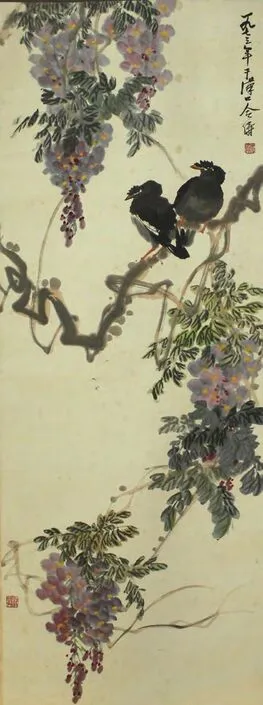
赵合俦画作 Painting by Zhao Hechou(1902-1982, traditional Chinese painter)
One morning when he was walking to the flea market near Yintong, someone behind him called out, “Excuse me!” He withdrew to the roadside to give way, and a junkman with a ragged load on his shoulders passed by.As he brushed past, Sheng Maobai was poked by a hard object.When he looked closer, he found a wooden scroll painting lying in the man’s ragged basket.
He hastily stopped the junkman, saying he wanted to have a look at the scroll.
The junkman set down his load on the roadside and said, “This is to be delivered to the waste collection station. Have a quick look and see what you want.”
Sheng Maobai opened the scroll and recognized Zhao Hechou’s painting of wisteria and starlings on a full six-chi(about 6.6 foot) paper scroll. The picture was vivid and vibrant with bursting old vines, thousands of flowers in subtly different shades of purple, and more than ten striking starlings on it.
Zhao Hechou was born in Huanggang, Hubei Province, next to Huangshi. In his early years he had learned from Xu Beihong in Beiping Art College. After a little bargaining, Sheng Maobai bought the scroll for 30 yuan. Since he only had a 50-yuan bill with him,he gave it all to the junkman, who was overjoyed since he’d only spent 5 yuan on buying the scroll and had now sold it for ten times that. Sheng Maobai also gave him a business card, telling the man to come to him when he got more paintings in future.
盛宁斋主捡漏记
文/刘益善
盛宁斋主盛茂柏是我多年的朋友。他命运多舛,坐了5年牢,后来平了反,回到原单位。上世纪90年代初,盛茂柏从黄石大冶的工作单位提前退休,到武汉来,开了一家不大的书画店,取名盛宁斋。开画店就是收画卖画,其高明处在于你会收会卖。我是盛宁斋的常客,一次酒足饭饱之后,他给我们讲了他收画时捡漏的故事。
木质画轴
一天早上,他步行去附近的银通旧货市场。突然,身后传来“让一下”的声音,待避到巷边,一个挑着破烂担子的拾荒者随声而到。擦身而过的瞬间,盛茂柏被一件硬物杵了一下。他定睛一看,破烂担子中歪躺着一根木质画轴。
他忙喊住拾荒者,让那人把担子停下,他要看看这卷画。
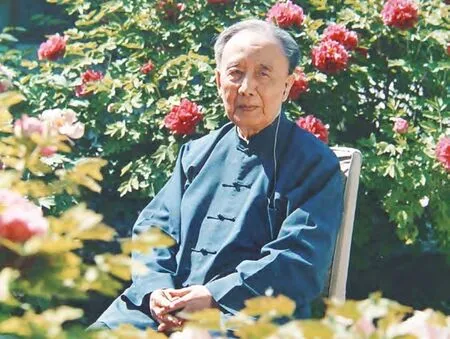
郭沫若及其书法作品 Guo Moruo (1892-1978, Chinese author, poet, historian, and archaeologist) and his calligraphy
拾荒者把担子停在路边,说:“这是要送到废品收购站的,你看看,要还是不要,抓紧时间。”
盛茂柏打开那轴画,认得是赵合俦的六尺整纸紫藤八哥大中堂。画上腾跃的老藤、万朵浓淡深浅紫花和十余只八哥,营造出一片勃勃生机。
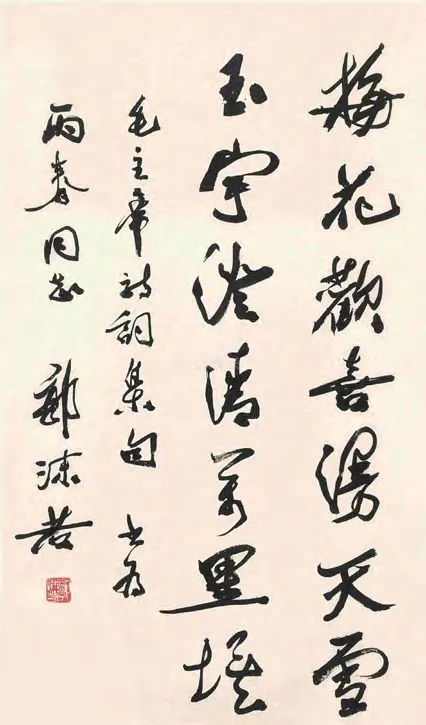
赵合俦是湖北黄冈人,早年肄业于北平艺专的徐悲鸿门下。经过简单讨价还价之后,盛茂柏30元人民币买下了这轴画。因随身只带了一张50元的钞票,他全部给了拾荒者。5块钱买的东西,一下子翻了十倍,拾荒者接过钱,感激不尽。盛茂柏给他一张名片,让拾荒者收到画后先卖给他。
这是盛茂柏到武汉投身书画收藏业后,捡到的第一件珍品。
有天傍晚,盛茂柏正和家人围桌吃晚饭,拾荒者打来电话,说他在老城区拆迁的地方,收到十多幅旧书画,有人追着他买,他不肯,一定要先给盛茂柏看了再说。
盛茂柏不敢怠慢,放下饭碗,急急忙忙地赶到拾荒者住的地方。看完那十多幅书画后,兴奋地对拾荒者说:“谢谢你的守信和对我的关照。这幅郭沫若的字、吕凤子的画,还有这四幅小名家的画、五副进士的对联,都是真迹。”
盛茂柏给拾荒者交了底,拾荒者听了,喃喃自语:“难怪那个人愿出五万块钱。”
盛茂柏问:“我把这批书画买下,你出个价吧。”
拾荒者说:“别人出五万我不卖,你给五万拿去吧。”
盛茂柏给了他六万块钱,成交。
红酸枝木箱子
一个夏天的傍晚,吃过晚饭,天色尚早,盛茂柏从武昌租住的地方去不远处的武泰闸旧家具市场,想去淘个木箱子装书画。
It was the first “treasure” Sheng Maobai obtained after he came to Wuhan and engaged in the field of painting and calligraphy collection.
One evening, Sheng Maobai and his family were having dinner when he got a call from this junkman, who told him that he had received more than ten old paintings in the old town. Some people were eager to buy those paintings, but he refused to sell,since he promised Sheng Maobai to check them out first.
Sheng Maobai immediately put down his bowl and rushed to the place where the junkman was.After inspecting the dozens of paintings and calligraphy, he told the junkman excitedly, “Thank you for your trust and kindness,these were all authentic works,including a calligraphy piece by Guo Moruo, a painting of Lyu Fengzi, four paintings of four less famous artists, and five couplets from a Jinshi.”1
Having heard the truth from Sheng Maobai, the junkman muttered to himself, “No wonder that man was willing to pay 50,000 yuan for them.”
Sheng Maobai said, “I would like to buy all of them, give me a price please.”
To which the junkman replied,“I didn’t want to sell them to that man for 50,000 yuan, but you can have them for this price.”
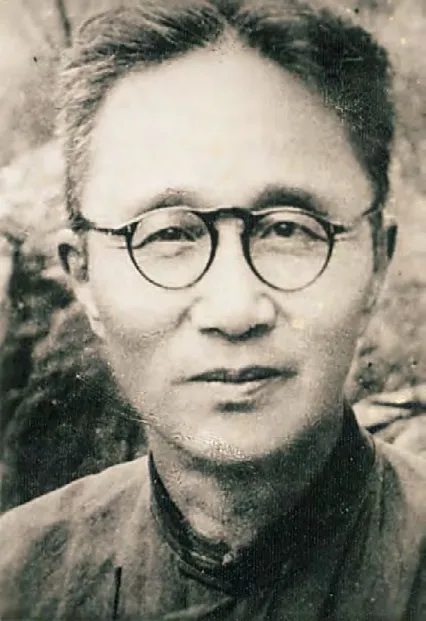
吕凤子及其画作 Lyu Fengzi (1886-1959, contemporary Chinese painter and calligraphy master) and his painting
Sheng Maobai gave him 60,000 yuan, and the deal was done.
A Red Rosewood Box
On a summer evening after dinner, Sheng Maobai left for the old furniture market in Wutaizha,which was not far from his rented place in Wuchang. He wanted to find a wooden box in which to put his paintings and calligraphy.
He went in and out of several stores to no avail.
Just when he was ready to go home, he found a large wooden box in a store at the end of the west corner, which had copper plaques on all four corners and a vintage old lock on its holder.After careful inspection, he was sure that this wooden box was made of red rosewood, a wellpreserved piece of furniture from the late Qing Dynasty (1636-1912).
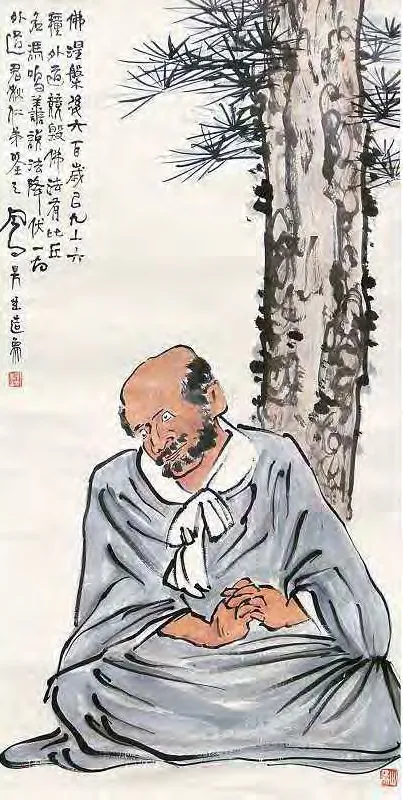
The owner noticed his interest in the wooden box, came over and said with enthusiasm that the material of this box was mahogany, and its price was 10,000 yuan.
Sheng Maobai did not reply.Instead he asked the owner to open the box for him to check inside for possible fake wood material at its bottom. The owner opened the lock and uncovered the lid. Inside the box scattered dozens of broken and moldy scrolls. Worrying this unpleasant scene might ruin his business, the owner hastily tried to explain why the box was not cleaned up.
他进出了几家店,都未看中。
正当他不抱什么希望,准备回家时,在西头最末一家店里发现了一只四角包着镂花铜片、铺首上横着一把老式旧锁的大木箱。细看之后确定,这木箱是红酸枝木做的,实属保存得比较好的晚清家具。

任伯年画作 Painting by Ren Bonian (1840-1896, painter born in Zhejiang Province,noted for his bold brushstrokes and use of color)
见他在打量木箱,店主踱了过来,热情地笑着说,这箱子的用料全是红木,要价一万块。
盛茂柏没有搭话。为了防止箱底有滥竽充数的杂木,他要店主把箱子打开看看。店主打开锁,揭开箱盖,里面满是横七竖八的卷轴,残破不堪,霉气扑鼻。店主怕砸了生意,慌忙向他解释没清理的原因。
盛茂柏顺手拣了一卷展开,仅看题款,就认定是任伯年的真迹。他不敢再去打开其他卷轴了,顺手将任伯年的卷轴放回箱中。他抑制住心跳,苦苦还价,谁知店主一分不让。
就在盛茂柏准备接受店主的要价时,冷不丁传来个女人的声音:“算了,就给八千八吧。”
原来是老板娘,盛茂柏最终八千元把木箱买到手。
盛茂柏从木箱中,清点出二十多幅字画,幅幅同一上款,都是真迹。这些字画使他大赚一笔,购置了一套三室一厅的商品房,一家人结束了租客的生活。
我也赚了
这天早上,盛茂柏从家里出来,走进小巷不久,被堆垒的杂物堵住。一年轻女子连连向过往行人致歉:“对不起,一会儿就来车拖走。”
盛茂柏正想从杂物旁侧身挤过去时,看到一个旧衣柜,小橱柜门上的玻璃破了,里面镶的是一幅国画。那熟悉的笔触,那使用花青的独到风格,无一不在自报家门:这是张肇铭先生的手泽。
盛茂柏双眼一亮,提出要买这幅画。不想,画主人赞他慧眼识宝,不愿谈钱,只愿相赠。他坚持无功不受禄,非要送点东西给物主作为交换。物主属虎,得知盛茂柏是个画家后,便请盛茂柏画了五只虎。
一周后,盛茂柏将一幅八尺水墨虎画,按物主所留地址送去。物主看了盛茂柏画的五只虎,赞不绝口地说:“五虎五福,好,好。我一张破画换了你这么大一幅新画,我赚了。”
盛茂柏说:“我也赚了。”
(摘自《黄河文学》2018年第3期)
Note:
1. Jinshi: a title for the successful candidate in the highest imperial examinations in ancient time.
Sheng Maobai randomly picked up a scroll and unfolded it. As soon as he saw the title, he knew it to be an authentic work by Ren Bonian. He refrained himself from opening more reels and put Ren Bonian’s scroll back into the box. Trying his best to appear calm, he had a hard haggling with the owner who was reluctant to budge on the price.
Just when Sheng Maobai was about to accept his price, a woman called from the back, “Forget it.Make it 8,800 yuan.”
As it turned out this was the wife of the owner. Sheng Maobai eventually got this wooden box for eight thousand yuan.
Back home Sheng Maobai cleared out more than 20 calligraphy works and paintings from the wooden box, which were all as authentic as the first one he had seen. He made a big fortune out of them, which bought him a three-bedroom commercial apartment and lifted his family out of their position as tenants.
A Win-Win Deal
One morning Sheng Maobai left home and walked into an alley,only to find himself blocked by a pile of debris. A young woman was standing there apologizing to the pedestrians. “Sorry, I will have these cleaned away very soon,”she said.
Sheng Maobai was trying to squeeze his way through when he saw an old wardrobe from the sundry. The glass on the small cabinet door was broken,and a Chinese painting was showing from inside. The familiar brushstroke and the unique style of color application made it all too obvious to him that this was a work crafted by the hands of Mr.Zhang Zhaoming.
Sheng Maobai was stunned and immediately proposed to buy the painting. The owner of the painting praised his artistic insight, but did not mean to sell it.She’d like to give it to him for free.Sheng Maobai insisted on giving something back in exchange, for he didn’t want to take something so valuable for nothing. Since the owner was born in Tiger Year according to the lunar calendar,after knowing that Sheng Maobai was a painter, she asked him to draw five tigers for her.
One week later, Sheng Maobai painted an eight-foot long piece of ink and washing painting of five tigers to the address left by the owner. Impressed by the tigers,the owner commended happily,“Five tigers mean five blessings,this is great. I got a brand new painting for a faded old picture!I’m so lucky.”
To which Sheng Maobai replied: “I’m lucky too.”
(FromThe Yellow River Literature, March 2018.Translation: Lu Qiongyao)
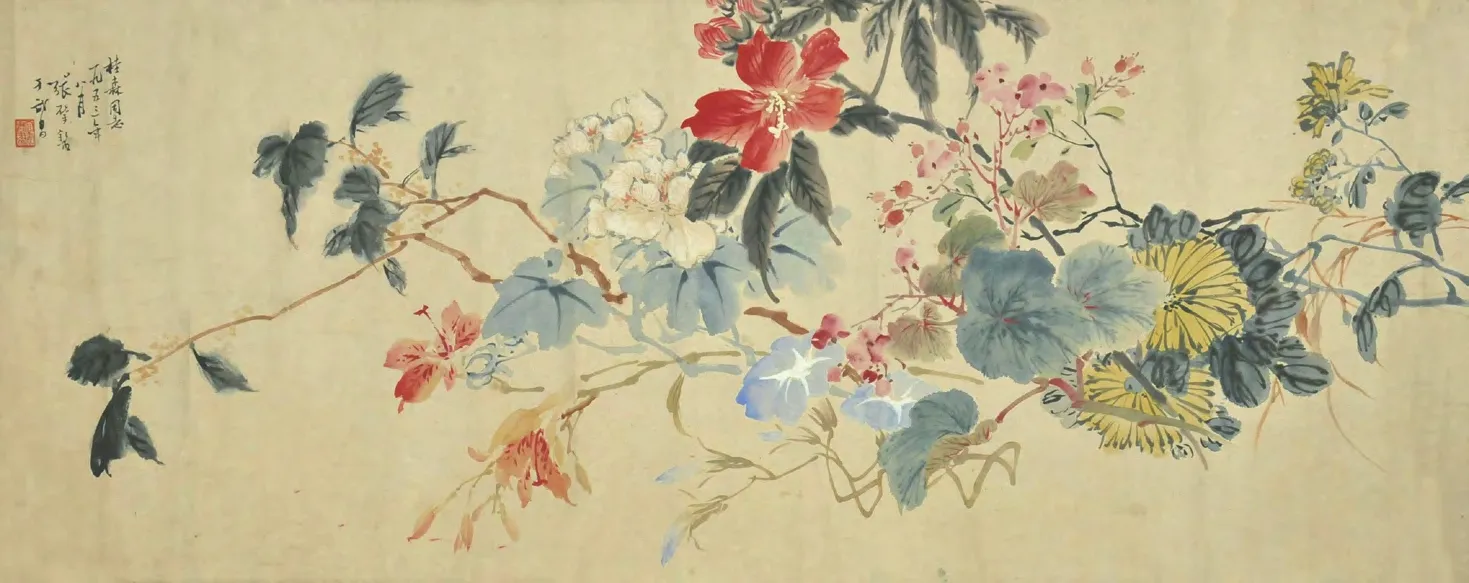
张肇铭画作 Painting by Zhang Zhaoming (1897-1976, artist from Hubei Province)
